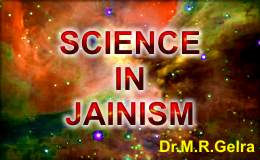
There are many aspects of existence, which Jain philosophers have described and explained ahead of the researches of modern science. One of them is the concept of 'Massless Matter'. Ancient Greek and Vedic philosophers believed that all matter in the Universe was made up of four basic elements, earth, air, fire and water. Aristotle argued that these elements were acted on by two forces: gravity and levity. The tendency of the earth and water to sink is due to gravity and the elements air and fire rise due to levity.
Jain philosophers were the first one, who believed that all the material existence can be divided into two categories: one carrying the mass (Gross matter) and the other carrying no mass (fine matter). This classification of matter is original and is based on the Jain Theory of the soul. The doctrine of soul is the central core of Jain Religion and philosophy. They maintain that all the souls of worldly beings are eternal and possess a cloud of Karma i.e. the bondage of fine massless karmic matter. Once the karmic matter is removed or annihilated and the influx of new karma is stopped, the worldly soul transforms into a pure, liberated soul.
The doctrine of soul has opened a gate to the studies on karmic matter under the name of 'Theory of Karma', which is very popular in Jain philosophy. It deals with the properties, behaviour, position, velocity etc. of the massless karmic matter. Probably, the Jain thinkers have done the earliest theoretical attempt on the studies on 'Massless matter'. It is remarkable that this division of the contents of the universe in two forms i.e. the gross and fine matter is still used today under the name of matter and force.
Up to the beginning of the twentieth century, Einstein firmly believed that the 'Mass is matter and matter is mass'. Hence, it was not proper on the part of the Jain philosophers to argue that matter and force carrying particles are synonymous with their philosophical terms of gross pudgala (massive) and the fine pudgala (massless) respectively. Now, we find that during the researches in particle physics in the sixties of 20th century, force-carrying particles like photon, graviton and gluon have been considered to be nearly massless. In this context, it is, interesting to study the concept of massless pudgala described in Jain philosophy, which is nearly two thousand years old philosophy.
The concept of massless matter in Jain literature has been elaborately discussed under the name of sukshma pudgala. Pudgala dravya is a synonym of the term matter. Pudgala is one of the six fundamental dravyas (Substances), which constitute the universe. Dravya means Satta, (existence).
The Jains hold that dravya exists in its own nature and has its own attributes and modifications. Pudgala has been distinguished from the rest of the five dravyas by its possession of touch, taste, smell and colour. These are the primary (eternal) attributes of pudgala. In addition to these essential attributes pudgala has certain samsthan i.e. form or figure of its own. Being a dravya these attributes are inseparable with it and are also in constant change of state. This ever-changing and renewing quality of pudgala is termed as paryaya, which involves both combination and dissociation. The change in magnitude and intensity in various essential attributes of pudgala causes the evolution of certain secondary qualities such as sound, cohesion, dimension, figure, divisibility, opacity, mass, radiant heat, light etc. All these attributes are derivatives and do not claim as essential attributes.
The distinguishing attributes have been further classified. Pudgala may have four or eight varieties of tactility, two tastes, two smells and five colours. The study of all these attributes is not directly related to the masslessness of pudgala and therefore reflections have been confined to tactility only. Out of eight forms of tactility (cold, hot, oily, dry, soft, coarse, light & heavy) discussion has been centred on two forms only, which are responsible for the evolution of mass. These forms are oily and dry.
It will be helpful to study the other classification of pudgala discussed in Jain literature. Pudgala exists in two forms.- Parmanu
- Skandh
 Dr. Mahavir Raj Gelra
Dr. Mahavir Raj Gelra

